.
The Harlem Renaissance
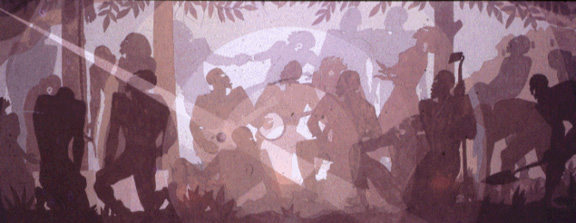
Aaron Douglas, Idylls of the Deep South, 1934
Between 1920-1930 an unprecedented outburst of creative activity
among African-Americans occurred in all fields of art. This African-American
cultural movement became known as "The New Negro Movement" and later as the
Harlem Renaissance. Harlem attracted a prosperous and stylish black middle
class from which sprang an extraordinary artistic center. Like avant-garde
movements in Europe, it embraced all art-forms, including music, dance, film,
theatre and cabaret. Harlem nightlife, with its dance halls and jazz bands,
featured prominently in the work of these artists. More than a literary movement
and more than a social revolt against racism, the Harlem Renaissance exalted
the unique culture of African-Americans and redefined African-American expression.
African-Americans were encouraged to celebrate their heritage and to become
"The New Negro," a term coined in 1925 by sociologist and critic Alain LeRoy
Locke. One of the factors contributing to the rise of the Harlem Renaissance
was the great migration of African-Americans to northern cities (such as New
York City, Chicago, and Washington, D.C.) between 1919 and 1926. In his influential
book The New Negro (1925), Locke described the northward migration of blacks
as "something like a spiritual emancipation."
"...Our problem is
to conceive, develop, establish an art era. Not white art painting
black...let's bare our arms and plunge them deep through laughter,
through pain, through sorrow, through hope, through disappointment,
into the very depths of the souls of our people and drag forth material
crude, rough, neglected. Then let's sing it, dance it, write it, paint
it. Let's do the impossible. Let's create something transcendentally
material, mystically objective. Earthy. Spiritually earthy. Dynamic." - Aaron Douglas
| |
| Aaron Douglas (1898-1979) was the Harlem Renaissance artist
whose work best exemplified the 'New Negro' philosophy. He painted
murals for public buildings and produced illustrations and cover
designs for many black publications including The Crisis and Opportunity. In 1940 he moved to Nashville, Tennessee,
where he founded the Art Department at Fisk University and tought
for twenty nine years. |
|
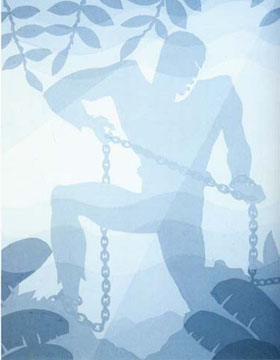
Aaron Douglas, study for God's Trombones |
Aaron Douglas completed the sketches above in preparation
for a mural he painted under WPA sponsorship for the 135th Street branch of
the New York Public Library in Harlem (now the Schomburg Center for Research
in Black Culture). The four-panel series Aspects of Negro Life tracks
the journey of African Americans from freedom in Africa to enslavement in
the United States and from liberation after the Civil War to life in the modern
city. In this study for the first panel, a man and woman in Africa dance to
the beat of drums as concentric circles of light emphasize the heat and rhythm
of their movements. A sculpture floating in a central circle above the dancers'
heads suggests the importance of spirits in African culture.
Song of the Towers represents the African-Americans' climb from
slavery to self-emancipation in the cities of America.

Lois Mailon Jones, Buddha, 1927 |
|
| Lois Jones attended the School of the Museum of Fine Art, Boston,
at a time when racial prejudice and discrimination were omnipresent
features of American life. Jones engineered her professional art
career in spite of barriers. Sometimes she entered works in exhibitions
that did not recognize African-American artists by having white
friends deliver the paintings. In other cases, prizes initially
awareded to her on merit were subsequently taken away and given
to white competitors. Despite these trials, Jones prevailed on
the basis of her talent, energy, and persistence. She refused
to be discouraged. |
from "The life and art of Lois Mailou Jones" Tritobia
Hayes Benjamin. 1994 |
|
| William H. Johnson arrived in Harlem when the Renaissance was
in the making. He had come to New York in 1918 from Florence,
South Carolina, and became a student at the national Academy of
Design. He remained there for five years, absorbing the teachings
of George Luks and Charles Hawthorne, and readying himself for
a career in art that would take him to places in North Africa
and Europe in search of a permanent residence. It was through
the influence of Hawthorne that Johnson traveled first to Paris
in 1926, where he settled, painted, and studied the works of modern
European masters. |
from "Harlem Renaissance: Art of Black America" |
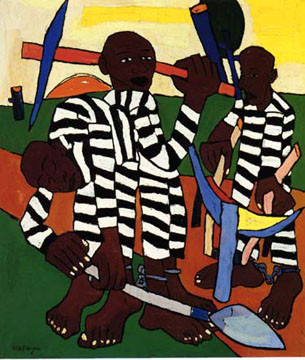
William Johnson, Chain Gang |
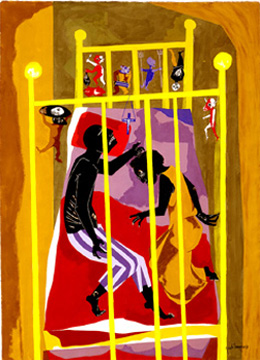
Jacob Lawrence, Dreams |
I've always
been interested in history, but they never taught Negro
history in the public schools... I don't see how a history
of the United States can be written honestly without including
the Negro.
ÑJacob Lawrence, 1940 |
|
|
Lawrence was the first American artist of African
descent to receive sustained mainstream recognition in the United
States. His success came earlyÑat the age of twenty-fourÑbut
lasted almost uninterrupted until his death in June 2000. His
renown is mostly in his "Migrantion" series, in which
he documents the migration of blacks from Africa to America,
focusing mostly on their history in the South. In the last ten
years of his life, he received numerous awards, including the
Presidential Medal of Arts and more than eighteen honorary post-doctorate
degrees.
|
|
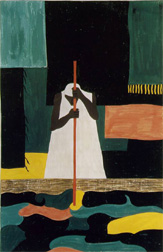
Female Laborer |
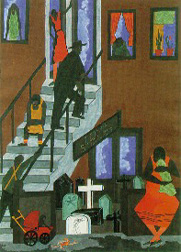
Tombstones |
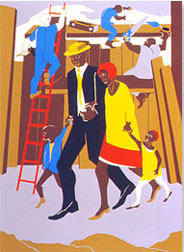
Builders |
Romare Bearden
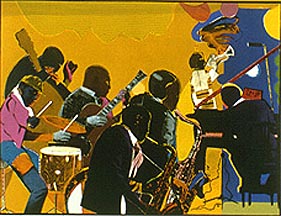
Jazz
|
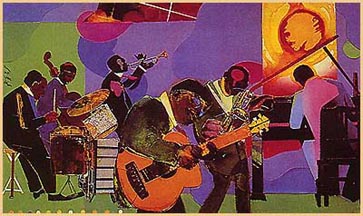
Jammin' at the Savoy
|
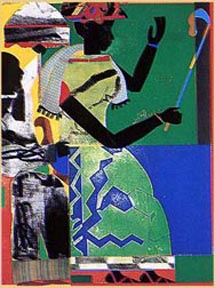
She-Ba
|
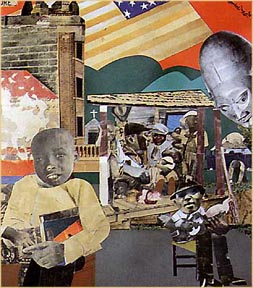
Soul History
|
Romare Bearden can best be described as a "descendent"
of the Harlem Renaissance, for the majority of his works were created a couple
of decades after the movement had ended. His paintings, collages and prints
celebrate black history, black music (jazz primarily an invention of black
musicians), and black lifestyles. Bright colors, unusual spatial compositions,
and a jubilant attitude frequently occupy his works.
|